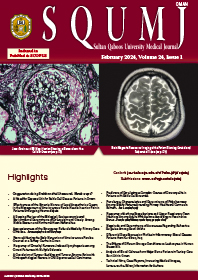Main Article Content
Abstract
Objectives: This study aimed to compare the high-flow nasal oxygen (HFNO) and supraglottic airway device (SAD) techniques in oncological patients undergoing endobronchial ultrasound (EBUS) and transbronchial needle aspiration (TBNA) to evaluate the efficacy of HFNO in them. Methods: This pilot study was conducted at Sultan Qaboos Comprehensive Cancer Care and Research Centre, Muscat, Oman, from May 2022 to March 2023. Patients undergoing EBUS TBNA under moderate sedation were quasi-randomised into the HFNO and SAD groups. The episodes and duration of hypoxia and the lowest level of oxygen saturation were the primary outcomes measured. Results: A total of 24 patients were included in the study (10 of them were in the HFNO group and 14 were in the SAD group), with an equal number of males and females. The duration of the procedure in both groups was similar (45 ± 20 and 44 ± 17 minutes in the HFNO and SAD groups, respectively). The mean lowest oxygen saturation in the HFNO group was 93.5 ± 4.5%, which was significantly higher than that of the SAD group (90 ± 3%; P <0.001). In both groups, maximum hypoxia occurred during the early phase of the procedure. However, the HFNO and SAD groups were similar in terms of the cumulative duration of hypotension (140 versus 95 seconds, respectively) and bradycardia (25 versus 40 seconds, respectively). Conclusion: HFNO is a good alternative to SAD and could be used safely and efficiently in patients undergoing EBUS TBNA.
Keywords: Sedation; Ultrasonography; Bronchi; Needle Aspiration; Oman.
Article Details

This work is licensed under a Creative Commons Attribution-NoDerivatives 4.0 International License.
